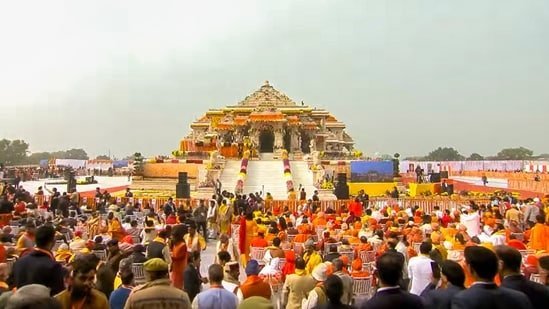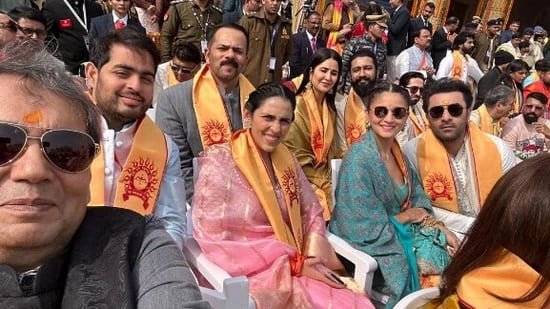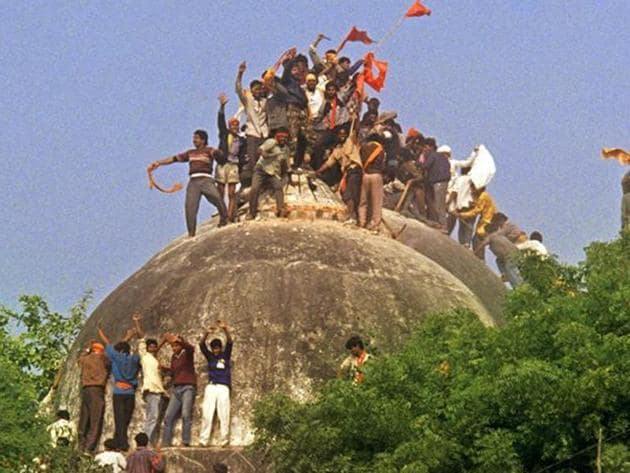On 22nd January, 2024 the Ram Mandir was inaugurated in Ayodhya, Uttar Pradesh, a land which is considered to be the hypothesised birthplace of Lord Ram by Hindus and has been rife with communal tension for about 500 years. On 22nd January, Prime Minister Narendra Modi inaugurated the temple and the idol of Lord Ram with hundreds of religious figures, Bollywood celebrities and politicians in attendance. The government announced partial holidays in several states and the inauguration ceremony was celebrated with gusto in several states with pujas and prashad distributions.
However, as most of the country rejoiced, the Ayodhya Ram Mandir also faced major criticism from academics, journalists and activists.
However, as most of the country rejoiced, the Ayodhya Ram Mandir also faced major criticism from academics, journalists and activists. For Muslims, the day symbolised one replete with terror and anxiety, as it laid bare the communal Hindutva chauvinism festering the nation. The temple is built on the ruins of the Babri Masjid, a 15th century Mughal-era mosque constructed by Babur’s commander Mir Baqi, which was brutally demolished by right wing extremists in 1992, sparking communal riots which changed India’s political landscape forever. The celebratory construction and the grand yet hastened inauguration of the Ram Mandir, months ahead of the national elections, have incurred criticism from the opposition as well as left activist circles, which claim the inauguration of the Mandir to be a calculated political move by the right wing government in power which has always attempted to stifle minority rights by championing Hindutva chauvinism.
Ayodhya: A brief history of the land that divides
In 1528, a mosque was built on the land by Babur’s commander. It was believed that the Babri masjid was built on the ruins of a Hindu temple in the Ram Janmabhoomi, the holy birthplace of Lord Ram.

In 1858, Nihang Sikhs were the first to claim the mosque as Ram’s birthplace, igniting the disputes around the land. Raghubar Das, a priest of the Nirmohi Akhara filed the first legal suit in 1885, seeking permission to build a temple on the outer courtyard of the mosque. The land was fenced and segregated by religion by the British to avoid further conflict. However, the placement of ‘Ram Lalla’ idols inside the temple on the night of 22nd December, 1949, sparked great furore regarding the mysterious “appearance” of the idols in the temple. The Nirmohi Akhara and the Sunni Central Waqf Board were embroiled in the legal court case over the land which continued till 2019.
In 1990, LK Advani took out a Rath Yatra, attempting to mobilise Hindu support amidst political strife. In 1992, the mosque was demolished by Hindu extremists, starting off riots across the nation, marking a watershed moment in India’s political history.
In 1992, the mosque was demolished by Hindu extremists, starting off riots across the nation, marking a watershed moment in India’s political history.
The land dispute continued, seeking evidence and support from the excavation findings by the Archaeological Survey of India. In 2019, the Supreme Court awarded the entire land to the Hindus, relocating the mosque to another site. The five judge constitution bench ruled that the entire 2.77 acres of disputed land in Ayodhya be handed over to a trust to be constituted for the construction of the Ram temple at the site, and five acres allotted at a ‘prominent site’ in Ayodhya to build a mosque. Prime Minister Narendra Modi laid the Ram Temple Foundation Stone in 2020 and the temple was inaugurated in 2024, just ahead of the national elections.
The Ram Mandir inauguration: Hindutva chauvinism, violence and terror for minorities
On 22nd January, the national celebrations at the inauguration of the Ayodhya Ram temple were unprecedented. Right wing Hindu outfits and their supporters celebrated the second coming of Ram with pujas and havans at the local level. Even educational institutions facilitated such celebrations with IIT-Bombay organising a Shobha yatra and the ABVP wing of Jadavpur University attempting to organise a Puja in the University premises. Dissenting voices were promptly stifled, with TISS authorities banning protests against the event on campus. In parts of the country, partial holiday was declared. The All India Institute of Medical Science (AIIMS) in Delhi had initially decided to close the Out Patient Department (OPD) for half a day because of the inauguration ceremony, however the decision was reversed following criticism from the opposition and activists.
The strong influence of BJP’s Hindutva political power was seen as the Mandir inauguration at Ayodhya saw a plethora of religious figures, industrialists, politicians and Bollywood celebrities pour in, draped in saffron attires.

Saffron terror unfolded in parts of the nation, especially on minority communities. In Mumbai’s Mira Road suburbs in Thane, communal clashes broke out after minority communities were provoked and forced to chant Hindu religious slogans, following which several establishments were bulldozed by the Mira Bhainder Municipal Corporations. Hindutva groups barged into FTII Pune, attacking students, chanting derogatory slogans and setting ablaze banners reading ‘Remember Babri’. A Hindutva mob in Telengana’s Sangareddy burnt down a Muslim man’s shop, chanting Islamophobic slogans and dancing to loud music. In MP’s Jhabua, a group of men chanting ‘Jai Shri Ram’ climbed atop a church and planted a saffron flag with a picture of the Ayodhya Ram Temple and ‘Jai Shri Ram’ inscribed on it on the Christian cross, on 21st January, a day before the Ram Mandir consecration ceremony. In Bihar’s Khirma village, a Muslim graveyard was set on fire by a celebratory procession.
The terror was also reflected in online spaces, with mass social media harassment and trolling of dissenting activists by Hindutva proponents. Female journalists like Rana Ayyub were sent rape and death threats following their posts on Ram Mandir on social media.
Understanding the political motive behind the inauguration of the Ram Mandir
As we near the 2024 national elections, the overt and covert political campaigns of the ruling government to stay in power become more and more visible. The BJP government led by Narendra Modi has been accused of using communal tensions to their favour, suppressing minority rights and propagating a singular hypermasculine Hindutva identity which subsumes all. The concocted narrative of ‘Hindu khatre mein hai’ has made the Hindu population in India aggressive and intolerant towards minority communities. Garnering such support from the Hindu communities in India, the BJP government has managed to stay in power for a decade now.
Critics argue, that the BJP’s inauguration of the Ayodhya Ram temple was an attempt to further consolidate this support to propel them through the elections and to secure yet another tenure in power.
Critics argue, that the BJP’s inauguration of the Ayodhya Ram temple was an attempt to further consolidate this support to propel them through the elections and to secure yet another tenure in power. This attempt to portray Modi as a saviour of Hindus has been markedly noticed in the posters and billboards promoting the Ram Mandir inauguration, where Modi’s face features alongside the image of the temple. In a series of streetlight hoardings, the figure of Modi even looms larger than Lord Ram’s, with the hoarding of the god looking minuscule, near the Prime Minister’s feet.
Religious strife in India has been time and again weaponised by right wing Hindutva proponents like the BJP to cultivate a false sense of victimhood in Hindus in India. As Marx had rightfully said, ‘Religion is the opium of the masses’ and the easiest and most fool-proof way to manipulate the national consciousness is by targeting their religious sentiments and brainwashing them over a period of time to inculcate in them a sense of savarna Hindutva chauvinism and a vile hatred for the religious ‘other’, the Indian Muslim. The inauguration of the Ram Mandir is being depicted by such right wing powers as historical justice and revenge wreaked on the Muslim “invader”. It is being portrayed as a religious win for Hindus who have campaigned to not just build a ‘mandir‘, but have crusaded for the ‘mandir’ to be built on the debris of a ‘masjid’.
The Ram Mandir, therefore, holds little spiritual significance for Hindutva proponents. It is a symbol of their political chauvinism; it marks the culmination of the saffronisation of India and is a well calculated move by political Hindutva powers to rally support in their crusade against minorities to build a Hindu-rashtra.
By conflating the figure of Modi with this moment of muscle flexing in the history of Hindutva and by orchestrating a reign of terror on minorities, BJP attempts to make sure the 2024 electoral odds are stacked in their favour. By making a messiah out of a man- Narendra Modi, the party attempts to pull a trump card which can turn the tide in their favour, by weaponising the strongest opiate of them all – religion.
What does the Mandir mean for secular India?
According to our constitution, India is a secular nation, priding itself on its “unity in diversity”. However in the past decade or so, there have been multiple attempts to violate the constitutional framework of the nation. A single saffron Hindutva identity has engulfed the national psyche and made its presence felt by inflicting terror on minorities.

The building of a grand Ram temple on the very land that signifies years of communal violence and discord, attacks the very core belief of secularism in the Indian constitution and consciousness. The inauguration foreshadows many more years of hate and intolerance against minority communities, especially Muslims, that are yet to come. In a nation, where religion and religiosities dictate politics, the Ram Mandir inauguration and the ensuing celebration of saffron terror is a seminal event which arguably marks the death of Indian secularism.
About the author(s)
Ananya Ray has completed her Masters in English from Jadavpur University, Kolkata, India. A published poet, intersectional activist and academic author, she has a keen interest in gender, politics and Postcolonialism.






